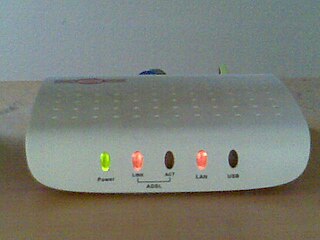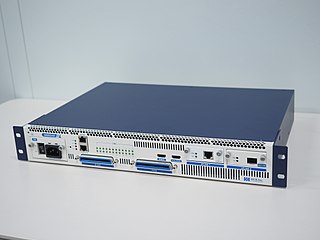Related Research Articles

Integrated Services Digital Network (ISDN) is a set of communication standards for simultaneous digital transmission of voice, video, data, and other network services over the digitalised circuits of the public switched telephone network. Work on the standard began in 1980 at Bell Labs and was formally standardized in 1988 in the CCITT "Red Book". By the time the standard was released, newer networking systems with much greater speeds were available, and ISDN saw relatively little uptake in the wider market. One estimate suggests ISDN use peaked at a worldwide total of 25 million subscribers at a time when 1.3 billion analog lines were in use. ISDN has largely been replaced with digital subscriber line (DSL) systems of much higher performance.
Digital subscriber line is a family of technologies that are used to transmit digital data over telephone lines. In telecommunications marketing, the term DSL is widely understood to mean asymmetric digital subscriber line (ADSL), the most commonly installed DSL technology, for Internet access.
A symmetric digital subscriber line (SDSL) is a digital subscriber line (DSL) that transmits digital data over the copper wires of the telephone network, where the bandwidth in the downstream direction, from the network to the subscriber, is identical to the bandwidth in the upstream direction, from the subscriber to the network. This symmetric bandwidth can be considered to be the opposite of the asymmetric bandwidth offered by asymmetric digital subscriber line (ADSL) technologies, where the upstream bandwidth is lower than the downstream bandwidth. SDSL is generally marketed at business customers, while ADSL is marketed at private as well as business customers.
The HomePNA Alliance is an incorporated non-profit industry association of companies that develops and standardizes technology for home networking over the existing coaxial cables and telephone wiring within homes, so new wires do not need to be installed.
Very high-speed digital subscriber line (VDSL) and very high-speed digital subscriber line 2 (VDSL2) are digital subscriber line (DSL) technologies providing data transmission faster than the earlier standards of asymmetric digital subscriber line (ADSL) G.992.1, G.992.3 (ADSL2) and G.992.5 (ADSL2+).
In telecommunications, ITU-T G.992.1 is an ITU standard for ADSL using discrete multitone modulation (DMT). G.dmt full-rate ADSL expands the usable bandwidth of existing copper telephone lines, delivering high-speed data communications at rates up to 8 Mbit/s downstream and 1.3 Mbit/s upstream.
Single-pair high-speed digital subscriber line (SHDSL) is a form of symmetric digital subscriber line (SDSL), a data communications technology for equal transmit and receive data rate over copper telephone lines, faster than a conventional voiceband modem can provide. As opposed to other DSL technologies, SHDSL employs trellis-coded pulse-amplitude modulation (TC-PAM). As a baseband transmission scheme, TC-PAM operates at frequencies that include those used by the analog voice plain old telephone service (POTS). As such, a frequency splitter, or DSL filter, cannot be used to allow a telephone line to be shared by both an SHDSL service and a POTS service at the same time. Support of symmetric data rates made SHDSL a popular choice by businesses for private branch exchange (PBX), virtual private network (VPN), web hosting and other data services.
Rate-adaptive digital subscriber line (RADSL) is a pre-standard asymmetric digital subscriber line (ADSL) solution. RADSL was introduced as proprietary technology by AT&T Paradyne, later GlobeSpan Technologies Inc., in June 1996. In September 1999, RADSL technology was formally described by ANSI in T1.TR.59-1999. RADSL supports downstream data rates of up to approximately 8 Mbit/s, upstream data rates up to approximately 1 Mbit/s, and can coexist with POTS voice on the same line.

G.992.5 is an ITU-T standard for asymmetric digital subscriber line (ADSL) broadband Internet access. The standard has a maximum theoretical downstream sync speed of 24 megabits per second (Mbit/s). Utilizing G.992.5 Annex M upstream sync speeds of 3.3 Mbit/s can be achieved.
Carrierless amplitude phase modulation (CAP) is a variant of quadrature amplitude modulation (QAM). Instead of modulating the amplitude of two carrier waves, CAP generates a QAM signal by combining two PAM signals filtered through two filters designed so that their impulse responses form a Hilbert pair. If the impulse responses of the two filters are chosen as sine and a cosine, the only mathematical difference between QAM and CAP waveforms is that the phase of the carrier is reset at the beginning of each symbol. If the carrier frequency and symbol rates are similar, the main advantage of CAP over QAM is simpler implementation. The modulation of the baseband signal with the quadrature carriers is not necessary with CAP, because it is part of the transmit pulse.
In telecommunications, ITU G.992.2 is an ITU standard for ADSL using discrete multitone modulation. G.lite does not strictly require the use of DSL filters, but like all variants of ADSL generally functions better with splitters.

ITU G.992.3 is an ITU standard, also referred to as ADSL2 or G.dmt.bis. It optionally extends the capability of basic ADSL in data rates to 12 Mbit/s downstream and, depending on Annex version, up to 3.5 Mbit/s upstream. ADSL2 uses the same bandwidth as ADSL but achieves higher throughput via improved modulation techniques. Actual speeds may decrease depending on line quality; usually the most significant factor in line quality is the distance from the DSLAM to the customer's equipment.

A DSL filter is an analog low-pass filter installed between analog devices and a plain old telephone service (POTS) line. The DSL filter prevents interference between such devices and a digital subscriber line (DSL) service connected to the same line. Without DSL filters, signals or echoes from analog devices at the top of their frequency range can reduce performance and create connection problems with DSL service, while those from the DSL service at the bottom of its range can cause line noise and other problems for analog devices.

Annex M is an optional specification in ITU-T recommendations G.992.3 (ADSL2) and G.992.5 (ADSL2+), also referred to as ADSL2 M and ADSL2+ M. This specification extends the capability of commonly deployed Annex A by more than doubling the number of upstream bits. The data rates can be as high as 12 or 24 Mbit/s downstream and 3 Mbit/s upstream depending on the distance from the DSLAM to the customer's premises.
High-bit-rate digital subscriber line (HDSL) is a telecommunications protocol standardized in 1994. It was the first digital subscriber line (DSL) technology to use a higher frequency spectrum over copper, twisted pair cables. HDSL was developed to transport DS1 services at 1.544 Mbit/s and 2.048 Mbit/s over telephone local loops without a need for repeaters. Successor technology to HDSL includes HDSL2 and HDSL4, proprietary SDSL, and G.SHDSL.

Annex J is a specification in ITU-T Recommendations G.992.3 and G.992.5 for all digital mode ADSL with improved spectral compatibility with ADSL over ISDN, which means that it is a type of naked DSL which will not disturb existing Annex B ADSL services in the same cable binder.

Asymmetric digital subscriber line (ADSL) is a type of digital subscriber line (DSL) technology, a data communications technology that enables faster data transmission over copper telephone lines than a conventional voiceband modem can provide. ADSL differs from the less common symmetric digital subscriber line (SDSL). In ADSL, bandwidth and bit rate are said to be asymmetric, meaning greater toward the customer premises (downstream) than the reverse (upstream). Providers usually market ADSL as an Internet access service primarily for downloading content from the Internet, but not for serving content accessed by others.
In electrical and electronics engineering, wetting current is the minimum electric current needing to flow through a contact to break through the surface film resistance at a contact. It is typically far below the contact's nominal maximum current rating.

G.fast is a digital subscriber line (DSL) protocol standard for local loops shorter than 500 meters, with performance targets between 100 Mbit/s and 1 Gbit/s, depending on loop length. High speeds are only achieved over very short loops. Although G.fast was initially designed for loops shorter than 250 meters, Sckipio in early 2015 demonstrated G.fast delivering speeds over 100 Mbit/s at nearly 500 meters and the EU announced a research project.
References
- ↑ "ITU-T Rec. G.992.4 (07/2002) Splitterless asymmetric digital subscriber line transceivers 2 (splitterless ADSL2)". International Telecommunication Union. Retrieved 26 December 2012.
- ↑ "ITU-T G.992.4 (07/2002)". ITU-T Recommendations database. ITU. Retrieved 2014-03-14.